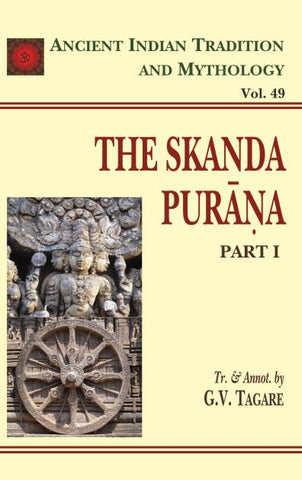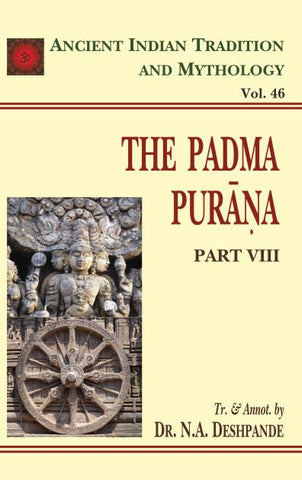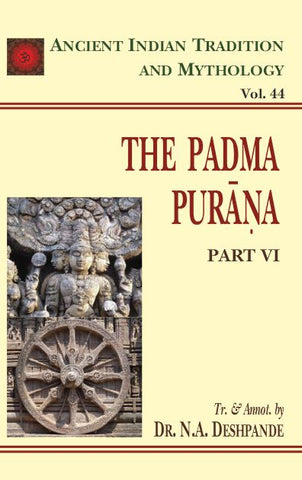Your cart is empty now.
Your search for "purana" revealed the following:
Siva Purana: Part 3 (AITM Vol. 3): Ancient Indian Tradition And Mythology
The Purana is a class of literature that treats ancient religion, philosophy, history, sociology, politics, and other subjects. It is an Encyclopaedia of various branches of knowledge and ancient wisdom. It has been defined as a class of literature that contains material on the topics of Creation, Dissolution of Manus, Ages of Manus, Genealogies, and the History of glorious kings. For dealing primarily with these subjects it has been called Pancalaksana a little that was incorporated in the Puranas themselves and had become popular by the Fifth Century A.D., for it was included by Amarasimha in his lexicon 'Amarakosa'. But... Read More
English & Sanskrit , 513 Pgs. (HB)Siva Purana: Part 4 (AITM Vol. 4): Ancient Indian Tradition And Mythology
The Purana is a class of literature that treats ancient religion, philosophy, history, sociology, politics, and other subjects. It is an Encyclopaedia of various branches of knowledge and ancient wisdom. It has been defined as a class of literature that contains material on the topics of Creation, Dissolution of Manus, Ages of Manus, Genealogies, and the History of glorious kings. For dealing primarily with these subjects it has been called Pancalaksana a little that was incorporated in the Puranas themselves and had become popular by the Fifth Century A.D., for it was included by Amarasimha in his lexicon 'Amarakosa'. But... Read More
English & Sanskrit, 564 Pgs. (HB)Skanda Purana Pt. 1 (AITM Vol. 49): Ancient Indian Tradition And Mythology
The present Part I, that is AITM Volume 49, comprises the whole of Kedarakhanda which is the first Section of Book I, i.e. Mahesvarakhanda, along with an Introduction and Index. This Section has thirty-five chapters which treat the oft-repeated themes of the self-immolation of Sati in the sacrifice of Daksa, the churning of the ocean, the elimination of demon Vrtra, the story of how Bali is outwitted by Vamana, the burning of Kamadeva by god Siva and the celebration of latter’s marriage with Parvati who wins him over by her severe penance, and the slaying of demon Taraka by Karttikeya... Read More
English, 400 Pgs. (HB)Padma Purana Pt. 8 (AITM Vol. 46): Ancient Indian Tradition And Mythology
This is part of a ten-volume work, vols 39-48 of the series on Ancient Indian Tradition and Mythology. Named after the lotus in which God Brahman appeared at the beginning of creation, this Purana starts with the narration of Cosmological and Cosmogonic myths. Then comes the description of royal dynasties both Solar and Lunar down to the time of Krsna. This is followed by the description of the war between Devas and Asuras and the defeat of Asuras by God Visnu. After the story of Prahlada comes the narrative of Rama preceded by the account of his predecessors beginning with... Read More
English, 400 Pgs. (HB)Padma Purana Pt. 6 (AITM Vol. 44): Ancient Indian Tradition And Mythology
This is part of a ten-volume work, vols 39-48 of the series on Ancient Indian Tradition and Mythology. Named after the lotus in which God Brahman appeared at the beginning of creation, this Purana starts with the narration of Cosmological and Cosmogonic myths. Then comes the description of royal dynasties both Solar and Lunar down to the time of Krsna. This is followed by the description of the war between Devas and Asuras and the defeat of Asuras by God Visnu. After the story of Prahlada comes the narrative of Rama preceded by the account of his predecessors beginning with... Read More
English, 400 Pgs. (HB)Padma Purana Pt. 5 (AITM Vol. 43): Ancient Indian Tradition And Mythology
This is part of a ten-volume work, vols 39-48 of the series on Ancient Indian Tradition and Mythology. Named after the lotus in which God Brahman appeared at the beginning of creation, this Purana starts with the narration of Cosmological and Cosmogonic myths. Then comes the description of royal dynasties both Solar and Lunar down to the time of Krsna. This is followed by the description of the war between Devas and Asuras and the defeat of Asuras by God Visnu. After the story of Prahlada comes the narrative of Rama preceded by the account of his predecessors beginning with... Read More
English, 400 Pgs. (HB)Padma Purana Pt. 3 (AITM Vol. 41): Ancient Indian Tradition And Mythology
This is part of a ten-volume work, vols 39-48 of the series on Ancient Indian Tradition and Mythology. Named after the lotus in which God Brahman appeared at the beginning of creation, this Purana starts with the narration of Cosmological and Cosmogonic myths. Then comes the description of royal dynasties both Solar and Lunar down to the time of Krsna. This is followed by the description of the war between Devas and Asuras and the defeat of Asuras by God Visnu. After the story of Prahlada comes the narrative of Rama preceded by the account of his predecessors beginning with... Read More
English, 400 Pgs. (HB)Padma Purana Pt. 4 (AITM Vol. 42): Ancient Indian Tradition And Mythology
This is part of a ten-volume work, vols 39-48 of the series on Ancient Indian Tradition and Mythology. Named after the lotus in which God Brahman appeared at the beginning of creation, this Purana starts with the narration of Cosmological and Cosmogonic myths. Then comes the description of royal dynasties both Solar and Lunar down to the time of Krsna. This is followed by the description of the war between Devas and Asuras and the defeat of Asuras by God Visnu. After the story of Prahlada comes the narrative of Rama preceded by the account of his predecessors beginning with... Read More
English, 400 Pgs. (HB)Padma Purana Pt. 2 (AITM Vol. 40): Ancient Indian Tradition And Mythology
This is part of a ten-volume work, vols 39-48 of the series on Ancient Indian Tradition and Mythology. Named after the lotus in which God Brahman appeared at the beginning of creation, this Purana starts with the narration of Cosmological and Cosmogonic myths. Then comes the description of royal dynasties both Solar and Lunar down to the time of Krsna. This is followed by the description of the war between Devas and Asuras and the defeat of Asuras by God Visnu. After the story of Prahlada comes the narrative of Rama preceded by the account of his predecessors beginning with... Read More
English, 400 Pgs. (HB)Vayu Purana Pt. 2 (AITM Vol. 38): Ancient Indian Tradition And Mythology
This two volume in the series on Ancient Indian Tradition and Mythology constitutes the first part (Purvardha) of the Vyu Purana of which the second part (Uttarardha). This part contains the English translation of Chapters 1-61 comprising the first two Padas or Sections out of the total four Padas into which the Purana is divided, viz. Prakrya, Upodghata, Anusanga and Upasainhara Padas. Read More
English, 544 Pgs. (HB)









